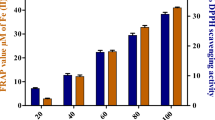Abstract
Cinnamon (Cinnamomum verum and C. cassia) is a medicinal plant, widely-used as a culinary spice. It possesses various therapeutic effects and can slow down the progression of neurological disorders impressively. In this article, the effects of hydro-alcohol extract and essential oil of C. verum and C. cassia and its main bioactive component cinnamaldehyde, has been examined on 6-OHDA-exposed PC12 cells as an in vitro model of Parkinson's disease. The cytotoxicity and cell apoptosis has been induced by 6-OHDA in PC12 cells. The protective effect was determined by measuring cell viability, the amount of reactive oxygen species (ROS), and apoptosis. Cell viability and apoptosis were assessed using resazurin assay, flow cytometry of propidium iodide (PI) stained cells, and western blot analysis. 6-OHDA resulted in the death and apoptosis of cells while, pretreatment with the extract and essential oil of C. verum and C. cassia at 20 µg/ml and cinnamaldehyde at 5 and 10 µM for 24 h could significantly increase the viability (p < 0.001), and decrease ROS content (p < 0.05). Pretreatment with the extracts increased survivin and decreased cyt-c whereas, pretreatment with the essential oil decreased cyt-c, increased survivin, and reduced P-p44/42/p44/42 levels to a level near that of the related control. The extract and essential oil of C. verum and C. cassia can be effective against 6-OHDA cytotoxicity. It is suggested that, the synergistic effects of cinnamaldehyde and other components of extract and essential oil promote cinnamon’s medicinal properties.





Similar content being viewed by others
Abbreviations
- PD:
-
Parkinson's disease
- 6-OHDA:
-
6-Hydroxydopamine
- SN:
-
Substantia nigra
- ROS:
-
Reactive oxygen species
- DMSO:
-
Dimethyl sulfoxide
- DCFH-DA:
-
2′,7′-dichlorofluorescin diacetate
- PI:
-
Propidiumiodide
- PBS:
-
Phosphate-buffer saline
- BHT:
-
Butylated hydroxytoluene
- SOD:
-
Superoxide dismutase
- CAT:
-
Catalase
- GOX:
-
Glucose oxidase
- GSH:
-
Glutathione
- ANOVA:
-
One-way analysis of variance
- NO:
-
Nitric oxide
- CC:
-
Cytotoxic concentration
- H2O2 :
-
Hydrogen peroxide
- TH:
-
Tyrosine hydroxylase
- CA:
-
Cinnamic aldehyde
- MPTP:
-
1-Methyl-4-phenyl-1,2,3,6-tetrahydropyridine
- LC3:
-
Light chain 3
- NaB:
-
Sodium benzoate
- iNOS:
-
Inducible nitric oxide synthase
- NF-κB:
-
Nuclear factor κB
- PKA:
-
Protein kinase A
- CREB:
-
Activation of cAMP response element binding
- CNS:
-
Central nervous system
- SOCS3:
-
Suppressor of cytokine signaling 3
- IL:
-
Interleukin
- TNF:
-
Tumor necrosis factor
- CEppt:
-
Cinnamon extract precipitation
- α-syn:
-
α-Synuclein
- Cyt-c:
-
Cytochrome c
References
Rao PV, Gan SH (2014) Cinnamon: a multifaceted medicinal plant. Evid Based Complement Altern Med 2014:642942–642955
Mollazadeh H, Hosseinzadeh H (2016) Cinnamon effects on metabolic syndrome: A review based on its mechanisms. Iran J Basic Med Sci 19:1258–1270
Liu XC, Cheng J, Zhao NN, Liu ZL (2014) Insecticidal activity of essential oil of Cinnamomum cassia and its main constituent, trans-cinnamaldehyde, against the booklice, Liposcelis bostrychophila. Trop J Pharm Res 13:1697–1702
Ranasinghe P, Pigera S, Premakumara GS, Galappaththy P, Constantine GR, Katulanda P (2013) Medicinal properties of ‘true’ cinnamon (Cinnamomum zeylanicum): a systematic review, BMC complement. Altern Med 13:275–285
Kawatra P, Rajagopalan R (2015) Cinnamon: mystic powers of a minute ingredient. Pharmacogn Res 7:S1–S6
Brahmachari S, Jana A, Pahan K (2009) Sodium benzoate, a metabolite of cinnamon and a food additive, reduces microglial and astroglial inflammatory responses. J Immunol 183:5917–5927
Khasnavis S, Pahan K (2012) Sodium benzoate, a metabolite of cinnamon and a food additive, upregulates neuroprotective Parkinson disease protein DJ-1 in astrocytes and neurons. J Neuroimmune Pharmacol 7:424–435
Grimes JD, Hassan MN, Thakar J (1987) Antioxidant therapy in Parkinson's disease. Can J Neurol Sci 14:483–487
Prasad KN, Cole WC, Kumar B (1999) Multiple antioxidants in the prevention and treatment of Parkinson's disease. J Am Coll Nutr 18:413–423
Roussel AM, Hininger I, Benaraba R, Ziegenfuss TN, Anderson RA (2009) Antioxidant effects of a cinnamon extract in people with impaired fasting glucose that are overweight or obese. J Am Coll Nutr 28:16–21
Pandey M, Chandra DR (2015) Evaluation of ethanol and aqueous extracts of Cinnamomum verumleaf galls for potential antioxidant and analgesic activity. Indian J Pharm Sci 77:243–247
Paranagama PA, Wimalasena S, Jayatilake GS, Jayawardena AL, Senanayake UM, Mubarak AM (2001) A comparison of essential oil constituents of bark, leaf, root and fruit of cinnamon (Cinnamomum zeylanicum Blum) grown in Sri Lanka. J Natl Sci Found 29:147–153
Kumar S, Vasudeva N, Sharma S (2012) GC-MS analysis and screening of antidiabetic, antioxidant and hypolipidemic potential of Cinnamomum tamala oil in streptozotocin induced diabetes mellitus in rats. Cardiovasc Diabetol 11:95–106
Lee HS, Kim BS, Kim MK (2002) Suppression effect of Cinnamomum cassia bark-derived component on nitric oxide synthase. J Agric Food Chem 50:7700–7703
Prakash D, Suri S, Upadhyay G, Singh BN (2007) Total phenol, antioxidant and free radical scavenging activities of some medicinal plants. Int J Food Sci Nutr 58:18–28
Nabavi SF, Di Lorenzo A, Izadi M, Sobarzo-Sánchez E, Daglia M, Nabavi SM (2015) Antibacterial effects of cinnamon: from farm to food, cosmetic and pharmaceutical industries. Nutrients 7:7729–7748
Maiolo SA, Fan P, Bobrovskaya L (2018) Bioactive constituents from cinnamon, hemp seed and Polygonum cuspidatum protect against H2O2 but not rotenone toxicity in a cellular model of Parkinson's disease. J Tradit Complement Med 8:420–427
Fu Y, Yang P, Zhao Y, Zhang L, Zhang Z, Dong X, Wu Z, Xu Y, Chen Y (2017) trans-cinnamaldehyde inhibits microglial activation and improves neuronal survival against neuroinflammation in BV2 microglial cells with lipopolysaccharide stimulation. Evid Based Complement Altern Med 2017:4730878–4730890
Bae WY, Choi JS, Jeong JW (2018) The neuroprotective effects of cinnamic aldehyde in an MPTP mouse model of Parkinson's disease. Int J Mol Sci 19:551–561
O'brien J, Wilson I, Orton T, Pognan F (2000) Investigation of the Alamar Blue (resazurin) fluorescent dye for the assessment of mammalian cell cytotoxicity. Eur J Biochem 267:5421–5426
Naserian M, Ramazani E, Iranshahi M, Tayarani-Najaran Z (2018) The role of SAPK/JNK pathway in the synergistic effects of metformin and dacarbazine on apoptosis in Raji and Ramos lymphoma cells. Curr Mol Pharmacol 11:336–342
Chen X, Zhong Z, Xu Z, Chen L, Wang Y (2010) 2',7'-Dichlorodihydrofluorescein as a fluorescent probe for reactive oxygen species measurement: forty years of application and controversy. Free Radic Res 44:587–604
Ramazani E, Tayarani-Najaran Z, Fereidoni M (2019) Celecoxib, indomethacin and ibuprofen prevent 6-hydroxydopamine-induced PC12 cell death through the inhibition of NF-κB and SAPK/JNK pathways. Iran J Basic Med Sci 22:477–484
Riccardi C, Nicoletti I (2006) Analysis of apoptosis by propidium iodide staining and flow cytometry. Nat Protoc 1:1458–1461
Tayarani-Najaran Z, Sareban M, Gholami A, Emami SA, Mojarrab M (2013) Cytotoxic and apoptotic effects of different extracts of Artemisia turanica Krasch. on K562 and HL-60 cell lines. Sci World J 2013:628073–628079
Lin CM, Lin RD, Chen ST, Lin YP, Chiu WT, Lin JW, Hsu FL, Lee MH (2010) Neurocytoprotective effects of the bioactive constituents of Pueraria thomsonii in 6-hydroxydopamine (6-OHDA)-treated nerve growth factor (NGF)-differentiated PC12 cells. Phytochemistry 71:2147–2156
Perumal AS, Tordzro WK, Katz M, Jackson-Lewis V, Cooper TB, Fahn S, Cadet JL (1989) Regional effects of 6-hydroxydopamine (6-OHDA) on free radical scavengers in rat brain. Brain Res 504:139–141
Zhang B, Shen Q, Chen Y, Pan R, Kuang S, Liu G, Sun G, Sun X (2017) Myricitrin alleviates oxidative stress-induced inflammation and apoptosis and protects mice against diabetic cardiomyopathy. Sci Rep 7:44239–44255
Lin CM, Lin RD, Chen ST, Lin YP, Chiu WT, Lin JW, Hsu FL, Lee MH (2010) Neurocytoprotective effects of the bioactive constituents of Pueraria thomsonii in 6-hydroxydopamine (6-OHDA)- treated nerve growth factor (NGF)-differentiated PC12 cells. Phytochemistry 71:2147–2156
Bohush A, Niewiadomska G, Filipek A (2018) Role of mitogen activated protein kinase signaling in Parkinson’s disease. Int J Mol Sci 19:2973–2990
Alves G, Forsaa EB, Pedersen KF, Gjerstad MD, Larsen JP (2008) Epidemiology of Parkinson's disease. J Neurol 255:18–32
Shahpiri Z, Bahramsoltani R, Farzaei MH, Farzaei F, Rahimi R (2016) Phytochemicals as future drugs for Parkinson's disease: a comprehensive review. Rev Neurosci 27:651–668
Momtaz S, Hassani S, Khan F, Ziaee M, Abdollahi M (2018) Cinnamon, a promising prospect towards Alzheimer's disease. Pharmacol Res 130:241–258
Khasnavis S, Pahan K (2014) Cinnamon treatment upregulates neuroprotective proteins Parkin and DJ-1 and protects dopaminergic neurons in a mouse model of Parkinson's disease. J Neuroimmune Pharmacol 9:569–581
Jana A, Modi KK, Roy A, Anderson JA, van Breemen RB, Pahan K (2013) Up-regulation of neurotrophic factors by cinnamon and its metabolite sodium benzoate: therapeutic implications for neurodegenerative disorders. J Neuroimmune Pharmacol 8:739–755
Chakrabarti S, Jana M, Roy A, Pahan K (2018) Upregulation of suppressor of cytokine signaling 3 in microglia by cinnamic Acid. Curr Alzheimer Res 15:894–904
Ho SC, Chang KS, Chang PW (2013) Inhibition of neuroinflammation by cinnamon and its main components. Food Chem 138:2275–2282
Shaltiel-Karyo R, Davidi D, Frenkel-Pinter M, Ovadia M, Segal D, Gazit E (2012) Differential inhibition of alpha-synuclein oligomeric and fibrillar assembly in parkinson's disease model by cinnamon extract. Biochim Biophys Acta 1820:1628–1635
Gao HL, Yu XJ, Liu KL, Shi XL, Qi J, Chen YM, Zhang Y, Bai J, Yi QY, Feng ZP, Chen WS (2017) PVN blockade of p44/42 MAPK pathway attenuates salt-induced hypertension through modulating neurotransmitters and attenuating oxidative stress. Sci Rep 7:43038–43048
Wortzel I, Seger R (2011) The ERK cascade: distinct functions within various subcellular organelles. Genes Cancer 2:195–209
Javadov S, Jang S, Agostini B (2014) Crosstalk between mitogen-activated protein kinases and mitochondria in cardiac diseases: therapeutic perspectives. Pharmacol Ther 144:202–225
Tangchirakhaphan S, Innajak S, Nilwarangkoon S, Tanjapatkul N, Mahabusrakum W, Watanapokasin R (2018) Mechanism of apoptosis induction associated with ERK1/2 upregulation via goniothalamin in melanoma cells. Exp Ther Med 15:3052–3058
Blum D, Torch S, Lambeng N, Nissou MF, Benabid AL, Sadoul R, Verna JM (2001) Molecular pathways involved in the neurotoxicity of 6-OHDA, dopamine and MPTP: contribution to the apoptotic theory in Parkinson's disease. Prog Neurobiol 65:135–172
Marusawa H, Matsuzawa SI, Welsh K, Zou H, Armstrong R, Tamm I, Reed JC (2003) HBXIP functions as a cofactor of survivin in apoptosis suppression. EMBO J 22:2729–2740
Acknowledgements
This work was supported by Grant No. 951831 from Research Affairs of Mashhad University of Medical Sciences. The authors wish to thank Mr. Malaekeh for reading flow cytometry test samples.
Funding
This work has been supported by Grant No.951831 from the Research Affairs of Mashhad University of Medical Sciences, Mashhad, Iran.
Author information
Authors and Affiliations
Contributions
Elham Ramazani performed the experiments, computations, analyzed the data, and wrote the manuscript. Mahdi Yazd Fazeli performed the experiments and computations. Seyed Ahmad Emami, Behjat Javadi and Javad Asili conceived, designed, and supervised the project, wrote the manuscript and final approval of the manuscript. Leila Mohtashami performed the experiments and reviewed the manuscript. Zahra Tayarani-Najaran conceived, designed, and supervised the project, wrote the manuscript, provided financial support and final approval of the manuscript.
Corresponding author
Ethics declarations
Conflict of interest
There is no conflict of interest in this study.
Ethical approval
This work is carried out on PC12 cells and there is no need for ethical clearance.
Additional information
Publisher's Note
Springer Nature remains neutral with regard to jurisdictional claims in published maps and institutional affiliations.
Rights and permissions
About this article
Cite this article
Ramazani, E., YazdFazeli, M., Emami, S.A. et al. Protective effects of Cinnamomum verum, Cinnamomum cassia and cinnamaldehyde against 6-OHDA-induced apoptosis in PC12 cells. Mol Biol Rep 47, 2437–2445 (2020). https://doi.org/10.1007/s11033-020-05284-y
Received:
Revised:
Accepted:
Published:
Issue Date:
DOI: https://doi.org/10.1007/s11033-020-05284-y




